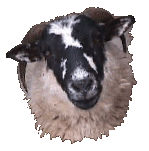For More Information!
HOME | home
Scottish Blackface | Scottish Blackface II | Scottish Blackface III | Scottish Blackface IV | Scottish Blackface VI | Scottish Blackface VII | Scottish Blackface V | Scottish Blackface VIII | Blackface IX | Blackface X | Scottish Blackface Breeders Guild | Blackface Guild 2 | Sheep Shearing | Photo Essay of Blackface | Piebald or Jacob Sheep | Soay Sheep | The Shepherds Bothy
Scottish Blackface Breeders Guild
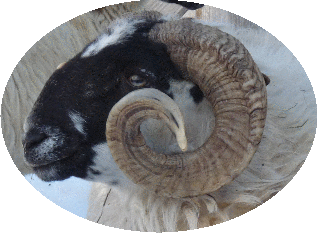
This is a not for profit , organization to promote Scottish Blackface Sheep in North America and Products made from Scottish Blackface wool and horn. We welcome you to sign up for the e-newsletter. We are not a registry. We except members with both registered and unregistered stock. To join the guild contact Beth. We had to give up on the paper newsletter for now due to the untimely death of one of our founding members, Randy Hatch.
Scottish Blackface Sheep
Also Known By: Blackface,
Blackfaced Highland, Kerry
Linton, Scottish Mountain, Scottish
Highland, Scotch Blackface, Scotch Horn
The introduction of Black Faced Highland sheep to America first occurred in June, 1861, Hugh Brodie imported one ram and two ewes for Brodie & Campbell, New York Mills, New York. In 1867 this flock and increase was purchased by T. L. Harison of Morley, St. Lawrence County, New York. Isaac Stickney of New York also imported a small flock about 1867 for his farm in Illinois.
In the UK early monastery records show that monks in the Twelfth Century raised sheep that are the progenitors of the modern Scottish Blackface breed. The monks used the wool of the dun-faced sheep, as they were often called, for their own clothing and exported large amounts to Europe. Latter records show that in 1503 James the IV of Scotland established a flock of 5,000 Scottish Blackface Sheep in Ettrick Forest. Today the Blackface is the most important breed in the British Isles. Thirty percent of all sheep in the UK are Scottish Blackface! The Blackface epitomizes the mountain sheep. They have long coarse wool that shields them from moisture and biting winds. They are able to survive the harshest winters in the most extreme parts of Great Britain.
Blackface ewes are excellent mothers and will often attempt to defend their lambs against predators. They are good milkers and are able to yield a lamb crop and a wool clip even when on marginal pastures. The breed spread from the border areas during the Ninetieth Century to the highlands and the islands of Scotland. They also crossed to Northern Ireland and the US. There are flocks scattered across the USA but this robust little breed has remained a minor breed. Its potential has never been realized in the States where it's stamina and tolerance of cold would be most valuable. Blackface lambs yield a carcassideal for the modern consumer The meat is free of superfluous fat and waste and is known the world over for its distinct flavor. Although they are not large sheep they have enormous potential for the production in the US of high quality lean lamb for today's health conscious consumer. These sheep are also ideal for organic farmers who want to produce excellent cuts of lean meat at a reasonable cost! Overseas Scottish Blackface wool is used in the production of fine carpets. It is highly prized as mattress stuffing and some grades are used in the manufacture of Irish and Scottish tweeds. Artistsians have long treasured the horns of the Blackface for the carving of shepherds crooks and walking sticks. In the US the fleeces are becoming of interest to fiber artists and hand spinners for use in tapestry and the making of rugs and saddle blankets.The Scottish Blackface Breeders Guild is working to educate the public on this fine breed and make people aware of its useful qualities in the United States and Canada.
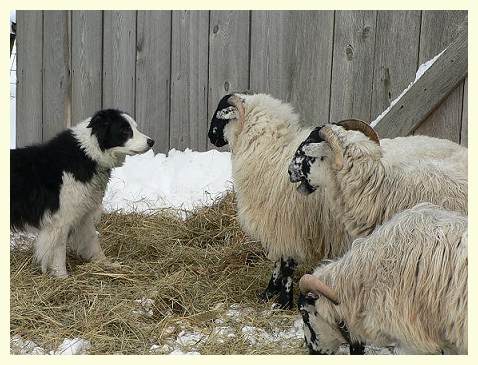
There has never been a case of natural occurring Scrapie in a Scottish Blackface Sheep. In a controlled study in the UK goats and Blackface where infected by researchers but there is not one documented case of naturally spread scrapie in a Blackface raised in the USA or the UK. Scrapie, an invariably fatal disease of sheep and goats, is a transmissible spongiform encephalopathy (TSE). The putative infectious agent is the host-encoded prion protein, PrP. The development of scrapie is closely linked to polymorphisms in the host PrP gene. The pathogenesis of most TSEs involves conversion of normal, cellular PrP into a protease-resistant, pathogenic isoform called PrPSc. The conversion to PrPSc involves change in secondary structure; it is impacts on these structural changes that may link polymorphisms to disease. Within the structured C-terminal part of PrP polymorphisms have been reported at 15 and 10 codons of the sheep and goat PrP genes respectively. Three polymorphisms in sheep are acutely linked to the occurrence of scrapie: A136V, R154H and Q171R / H. These generate five commonly observed alleles: ARQ, ARR, AHQ, ARH and VRQ. ARR and AHQ are associated with resistance; ARQ, ARH and VRQ are associated with susceptibility. There are subtle effects of specific allele pairings (genotypes). Generally, more susceptible genotypes have younger ages at death from scrapie. Different strains of scrapie occur which may attack genotypes differently. Different sheep breeds vary in the assortment of the five alleles that they predominantly encode. The reason for this variation is not known. Furthermore, certain genotypes may be susceptible to scrapie in some breeds and resistant in others. The explanation is not known, but may relate to different scrapie strains circulating in different breeds, or there may be effects of other genes which modulate the effect of PrP. There is no treatment, although the disease was eradicated from Australia and New Zealand by compulsory slaughter of imported sheep and flockmates shortly after release from quarantine. After the disease first appeared in the USA (in 1947), the Scrapie Eradication Program was established. This involved identification of affected animals and destruction of all sheep in the flock as well as other exposed flocks. This procedure was modified in 1983 to destroy mainly bloodline animals because of the strong familial occurrence of the disease. The current program in the USA is based on active, passive, and slaughter surveillance with removal of genetically susceptible sheep from flocks in which scrapie is detected. An eradication scheme has begun in the UK based on PrP gene susceptibility. It aims to replace scrapie-susceptible PrP alleles with more resistant ones, thereby controlling and eventually eliminating the disease from the national flock. In the USA the Suffolk and Hampshire present most cases of Scrapie and the Scottish Blackface none. For this reason it would be honest to relate to potential customers that Scottish Blackface meat is very safe to consume both in the USA and UK.
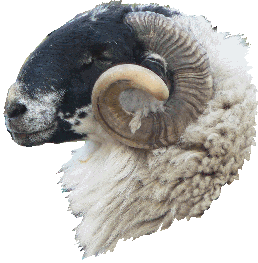
The Scottish Blackface Breeders Guild
3680 Panama-Stedman Road
Mayville, NY 14757
USA
Phone 716-789-5804
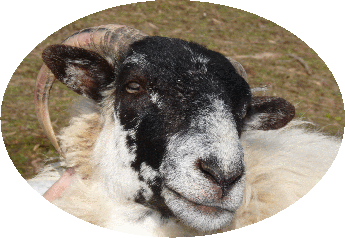
copyright 2002 , Jim & Beth Boyle, All Rights Reserved
No part of this website may be used for any purpose ( including using images )
